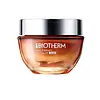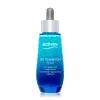What's inside
What's inside
 Key Ingredients
Key Ingredients

 Benefits
Benefits

 Concerns
Concerns

 Ingredients Side-by-side
Ingredients Side-by-side

Water
Skin ConditioningGlycerin
HumectantPropanediol
SolventIsopropyl Lauroyl Sarcosinate
Skin ConditioningCera Alba
EmollientBeeswax
Emulsion StabilisingDimethicone
EmollientCetyl Alcohol
EmollientButyrospermum Parkii Butter
Skin ConditioningZea Mays Germ Oil
EmollientZea Mays Oil
EmulsifyingElaeis Guineensis Oil
EmollientElaeis Guineensis Kernel Oil
EmollientAlcohol Denat.
AntimicrobialGlyceryl Stearate
EmollientPEG-100 Stearate
Stearic Acid
CleansingMyristyl Myristate
EmollientAmmonium Polyacryloyldimethyl Taurate
Emulsion StabilisingOryza Sativa Bran Oil
EmollientSecale Cereale Seed Extract
AbrasiveLaminaria Ochroleuca Extract
Skin ConditioningCyathea Medullaris Leaf Extract
Skin ConditioningBetaine
HumectantSorbitan Oleate
EmulsifyingSorbitan Tristearate
EmulsifyingCalcium PCA
HumectantGlyceryl Caprylate
EmollientIsohexadecane
EmollientSodium Hyaluronate
HumectantSodium Levulinate
Skin ConditioningSilica Silylate
EmollientMyristic Acid
CleansingPalmitic Acid
EmollientAdenosine
Skin ConditioningCinnamic Acid
PerfumingVitreoscilla Ferment
Skin ConditioningCitric Acid
BufferingTrisodium Ethylenediamine Disuccinate
Acetyl Tetrapeptide-9
Skin ConditioningXanthan Gum
EmulsifyingPentylene Glycol
Skin ConditioningLevulinic Acid
PerfumingResveratrol
AntioxidantPolysorbate 80
EmulsifyingAcrylamide/Sodium Acryloyldimethyltaurate Copolymer
Emulsion StabilisingButylene Glycol
HumectantTocopherol
AntioxidantPhenoxyethanol
PreservativeCI 77491
Cosmetic ColorantIron Oxides
CI 77891
Cosmetic ColorantTitanium Dioxide
Cosmetic ColorantMica
Cosmetic ColorantParfum
MaskingWater, Glycerin, Propanediol, Isopropyl Lauroyl Sarcosinate, Cera Alba, Beeswax, Dimethicone, Cetyl Alcohol, Butyrospermum Parkii Butter, Zea Mays Germ Oil, Zea Mays Oil, Elaeis Guineensis Oil, Elaeis Guineensis Kernel Oil, Alcohol Denat., Glyceryl Stearate, PEG-100 Stearate, Stearic Acid, Myristyl Myristate, Ammonium Polyacryloyldimethyl Taurate, Oryza Sativa Bran Oil, Secale Cereale Seed Extract, Laminaria Ochroleuca Extract, Cyathea Medullaris Leaf Extract, Betaine, Sorbitan Oleate, Sorbitan Tristearate, Calcium PCA, Glyceryl Caprylate, Isohexadecane, Sodium Hyaluronate, Sodium Levulinate, Silica Silylate, Myristic Acid, Palmitic Acid, Adenosine, Cinnamic Acid, Vitreoscilla Ferment, Citric Acid, Trisodium Ethylenediamine Disuccinate, Acetyl Tetrapeptide-9, Xanthan Gum, Pentylene Glycol, Levulinic Acid, Resveratrol, Polysorbate 80, Acrylamide/Sodium Acryloyldimethyltaurate Copolymer, Butylene Glycol, Tocopherol, Phenoxyethanol, CI 77491, Iron Oxides, CI 77891, Titanium Dioxide, Mica, Parfum
Water
Skin ConditioningBifida Ferment Lysate
Skin ConditioningGlycerin
HumectantAlcohol Denat.
AntimicrobialDimethicone
EmollientHydroxyethylpiperazine Ethane Sulfonic Acid
BufferingPhenoxyethanol
PreservativeOctyldodecanol
EmollientSodium Hyaluronate
HumectantCaprylyl Glycol
EmollientAmmonium Polyacryloyldimethyl Taurate
Emulsion StabilisingVitreoscilla Ferment
Skin ConditioningAscorbyl Glucoside
AntioxidantAdenosine
Skin ConditioningXanthan Gum
EmulsifyingPEG-20 Methyl Glucose Sesquistearate
EmulsifyingEthylenediamine
Pentylene Glycol
Skin ConditioningFaex Extract
Skin ConditioningSodium Hydroxide
BufferingSodium Benzoate
MaskingPEG-60 Hydrogenated Castor Oil
EmulsifyingHydrolyzed Hyaluronic Acid
HumectantSalicyloyl Phytosphingosine
Skin ConditioningTocopherol
AntioxidantParfum
MaskingWater, Bifida Ferment Lysate, Glycerin, Alcohol Denat., Dimethicone, Hydroxyethylpiperazine Ethane Sulfonic Acid, Phenoxyethanol, Octyldodecanol, Sodium Hyaluronate, Caprylyl Glycol, Ammonium Polyacryloyldimethyl Taurate, Vitreoscilla Ferment, Ascorbyl Glucoside, Adenosine, Xanthan Gum, PEG-20 Methyl Glucose Sesquistearate, Ethylenediamine, Pentylene Glycol, Faex Extract, Sodium Hydroxide, Sodium Benzoate, PEG-60 Hydrogenated Castor Oil, Hydrolyzed Hyaluronic Acid, Salicyloyl Phytosphingosine, Tocopherol, Parfum
Ingredients Explained
These ingredients are found in both products.
Ingredients higher up in an ingredient list are typically present in a larger amount.
Adenosine is in every living organism. It is one of four components in nucleic acids that helps store our DNA.
Adenosine has many benefits when used. These benefits include hydrating the skin, smoothing skin, and reducing wrinkles. Once applied, adenosine increases collagen production. It also helps with improving firmness and tissue repair.
Studies have found adenosine may also help with wound healing.
In skincare products, Adenosine is usually derived from yeast.
Learn more about AdenosineAlcohol Denat. is an alcohol with a denaturant property. It is created by mixing ethanol with other additives.
This ingredient gets a bad rep because it is irritating and drying - mostly due to its astringent property. Astringents draw out natural oils in tissue, constricting pores and leaving your skin dried out.
However, alcohol denat. is not all that bad.
Due to its low molecular weight, alcohol denat. tends to evaporate quickly. One study on pig skin found half of applied alcohol evaporated in 10 seconds and less than 3% stayed on skin.
This also helps other ingredients become better absorbed upon application.
Studies are conflicted about whether this ingredient causes skin dehydration. One study from 2005 found adding emollients to propanol-based sanitizer decreased skin dryness and irritation. Another study found irritation only occurs if your skin is already damaged.
Small amounts of alcohol are generally tolerated by oily skin or people who live in humid environments.
The rule of thumb is if this alcohol is near the end of an ingredients list, it will probably not affect your skin much.
Also...
This ingredient has antimicrobial and solvent properties.
The antimicrobial property helps preserve products and increase their shelf life. As a solvent, it helps dissolve other ingredients.
Other types of astringent alcohols include:
Learn more about Alcohol Denat.Ammonium Polyacryloyldimethyl Taurate is a polymer made from ammonium salts. It helps add stability and texture to a product. This ingredient is stable over a wide pH range.
Due to its ability to absorb water, it can help thicken the texture of a product. As an emulsion stabilizer, this ingredient is stabilizes other ingredients to create a consistent texture.
According to a manufacturer, it helps create a "smooth, light and fresh" texture.
Learn more about Ammonium Polyacryloyldimethyl TaurateDimethicone is a type of synthetic silicone created from natural materials such as quartz.
What it does:
Dimethicone comes in different viscosities:
Depending on the viscosity, dimethicone has different properties.
Ingredients lists don't always show which type is used, so we recommend reaching out to the brand if you have questions about the viscosity.
This ingredient is unlikely to cause irritation because it does not get absorbed into skin. However, people with silicone allergies should be careful about using this ingredient.
Note: Dimethicone may contribute to pilling. This is because it is not oil or water soluble, so pilling may occur when layered with products. When mixed with heavy oils in a formula, the outcome is also quite greasy.
Learn more about DimethiconeGlycerin is already naturally found in your skin. It helps moisturize and protect your skin.
A study from 2016 found glycerin to be more effective as a humectant than AHAs and hyaluronic acid.
As a humectant, it helps the skin stay hydrated by pulling moisture to your skin. The low molecular weight of glycerin allows it to pull moisture into the deeper layers of your skin.
Hydrated skin improves your skin barrier; Your skin barrier helps protect against irritants and bacteria.
Glycerin has also been found to have antimicrobial and antiviral properties. Due to these properties, glycerin is often used in wound and burn treatments.
In cosmetics, glycerin is usually derived from plants such as soybean or palm. However, it can also be sourced from animals, such as tallow or animal fat.
This ingredient is organic, colorless, odorless, and non-toxic.
Glycerin is the name for this ingredient in American English. British English uses Glycerol/Glycerine.
Learn more about GlycerinParfum is a catch-all term for an ingredient or more that is used to give a scent to products.
Also called "fragrance", this ingredient can be a blend of hundreds of chemicals or plant oils. This means every product with "fragrance" or "parfum" in the ingredients list is a different mixture.
For instance, Habanolide is a proprietary trade name for a specific aroma chemical. When used as a fragrance ingredient in cosmetics, most aroma chemicals fall under the broad labeling category of “FRAGRANCE” or “PARFUM” according to EU and US regulations.
The term 'parfum' or 'fragrance' is not regulated in many countries. In many cases, it is up to the brand to define this term.
For instance, many brands choose to label themselves as "fragrance-free" because they are not using synthetic fragrances. However, their products may still contain ingredients such as essential oils that are considered a fragrance by INCI standards.
One example is Calendula flower extract. Calendula is an essential oil that still imparts a scent or 'fragrance'.
Depending on the blend, the ingredients in the mixture can cause allergies and sensitivities on the skin. Some ingredients that are known EU allergens include linalool and citronellol.
Parfum can also be used to mask or cover an unpleasant scent.
The bottom line is: not all fragrances/parfum/ingredients are created equally. If you are worried about fragrances, we recommend taking a closer look at an ingredient. And of course, we always recommend speaking with a professional.
Learn more about ParfumPentylene glycol is typically used within a product to thicken it. It also adds a smooth, soft, and moisturizing feel to the product. It is naturally found in plants such as sugar beets.
The hydrophilic trait of Pentylene Glycol makes it a humectant. As a humectant, Pentylene Glycol helps draw moisture from the air to your skin. This can help keep your skin hydrated.
This property also makes Pentylene Glycol a great texture enhancer. It can also help thicken or stabilize a product.
Pentylene Glycol also acts as a mild preservative and helps to keep a product microbe-free.
Some people may experience mild eye and skin irritation from Pentylene Glycol. We always recommend speaking with a professional about using this ingredient in your routine.
Pentylene Glycol has a low molecular weight and is part of the 1,2-glycol family.
Learn more about Pentylene GlycolPhenoxyethanol is a preservative that has germicide, antimicrobial, and aromatic properties. Studies show that phenoxyethanol can prevent microbial growth. By itself, it has a scent that is similar to that of a rose.
It's often used in formulations along with Caprylyl Glycol to preserve the shelf life of products.
Sodium Hyaluronate is hyaluronic acid's salt form. It is commonly derived from the sodium salt of hyaluronic acid.
Like hyaluronic acid, it is great at holding water and acts as a humectant. This makes it a great skin hydrating ingredient.
Sodium Hyaluronate is naturally occurring in our bodies and is mostly found in eye fluid and joints.
These are some other common types of Hyaluronic Acid:
Learn more about Sodium HyaluronateTocopherol (also known as Vitamin E) is a common antioxidant used to help protect the skin from free-radicals and strengthen the skin barrier. It's also fat soluble - this means our skin is great at absorbing it.
Vitamin E also helps keep your natural skin lipids healthy. Your lipid skin barrier naturally consists of lipids, ceramides, and fatty acids. Vitamin E offers extra protection for your skin’s lipid barrier, keeping your skin healthy and nourished.
Another benefit is a bit of UV protection. Vitamin E helps reduce the damage caused by UVB rays. (It should not replace your sunscreen). Combining it with Vitamin C can decrease sunburned cells and hyperpigmentation after UV exposure.
You might have noticed Vitamin E + C often paired together. This is because it is great at stabilizing Vitamin C. Using the two together helps increase the effectiveness of both ingredients.
There are often claims that Vitamin E can reduce/prevent scarring, but these claims haven't been confirmed by scientific research.
Learn more about TocopherolVitreoscilla Ferment is a probiotic derived from the Vitreoscilla bacteria.
Studies show Vitreoscilla Ferment to have the same benefits as ingesting probiotics. Probiotics help keep the bacteria in your body healthy.
In general, maintaining a healthy microbiome on your skin has many benefits. One benefit is protection against external and bad bacteria. A healthy microbiome also helps maintain skin hydration and reduce inflammation.
Probiotics work best when combined with prebiotics.
Learn more about Vitreoscilla FermentWater. It's the most common cosmetic ingredient of all. You'll usually see it at the top of ingredient lists, meaning that it makes up the largest part of the product.
So why is it so popular? Water most often acts as a solvent - this means that it helps dissolve other ingredients into the formulation.
You'll also recognize water as that liquid we all need to stay alive. If you see this, drink a glass of water. Stay hydrated!
Learn more about WaterXanthan gum is used as a stabilizer and thickener within cosmetic products. It helps give products a sticky, thick feeling - preventing them from being too runny.
On the technical side of things, xanthan gum is a polysaccharide - a combination consisting of multiple sugar molecules bonded together.
Xanthan gum is a pretty common and great ingredient. It is a natural, non-toxic, non-irritating ingredient that is also commonly used in food products.
Learn more about Xanthan Gum